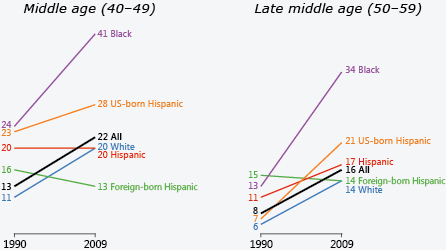Marriage Trends and Women's Benefits: Differences by Race-Ethnicity and Nativity
February 2014Women's potential eligibility for spousal and survivor benefits based on their marital history varies significantly by race and ethnicity 1
For example, in 2009, 34 percent of black women aged 50–59 had marital histories that made them ineligible for spousal or survivor benefits, compared with 14 percent of non-Hispanic white women and 17 percent of Hispanic women of the same age.
The proportion of women aged 40 to 59 without qualifying marriages for spousal and survivor benefits increased between 1990 and 2009, particularly among black women
For example, 41 percent of black women age 40 to 49 lacked a qualifying marriage in 2009, compared to 20 percent of white women, a difference of 21 percentage points. In 1990, the difference was about 13 percentage points (24 percent black and 11 percent white). 2 This widening gap is driven, in large part, by a higher proportion of black women who never marry among more recent cohorts. 1, 2
Among Hispanic women, potential eligibility for spouse and survivor benefits based on marital history varies substantially by nativity
In 2009, more US-born Hispanic women lacked a qualifying marriage (21 percent for ages 50–59 and 28 percent ages 40–49) than foreign-born (14 percent for ages 50–59 and 13 percent ages 40–49). The composition of the Hispanic population is heterogeneous and has changed greatly from 1990 to 2009 with recent waves of immigration. 1

| Race-ethnicity and nativity | Middle age (40–49) |
Late middle age (50–59) | ||
|---|---|---|---|---|
| 1990 | 2008 | 1990 | 2008 | |
| All | 13 | 22 | 8 | 16 |
| White | 11 | 20 | 6 | 14 |
| Black | 24 | 41 | 13 | 34 |
| Hispanic | 20 | 20 | 11 | 17 |
| US-born Hispanic | 23 | 28 | 7 | 21 |
| Foreign-born Hispanic | 16 | 13 | 15 | 14 |
Background
- Social Security provides benefits to spouses or widow(er)s of insured workers. Eligibility depends on a person's marital history and his or her lifetime earnings relative to a current or previous spouse.
- Under the marital history requirement, a person must be currently married, widowed, or divorced from a marriage of at least 10 years.
- The Social Security program treats persons with identical earnings or marital histories the same, but differences in marital patterns by race/ethnicity and nativity can result in differences in eligibility for marriage-based Social Security benefits by these characteristics.
1 Iams, Howard M. and Christopher R. Tamborini. 2012. "The Implications of Marital History Change on Women's Eligibility for Social Security Wife and Widow Benefits, 1990–2009." Social Security Bulletin 72(2): 23–38. See also Tamborini, Christopher R., Howard M. Iams, and Kevin Whitman. 2009. "Marital History, Race, and Social Security Spouse and Widow Benefit Eligibility in the United States." Research on Aging 31(5): 577–605.
2 These relationships hold controlling for key socioeconomic and demographic characteristics in regression analysis.
NOTES: All content is simplified for presentation. Please see source material for full details and caveats.
The findings and conclusions presented in this summary are those of the authors and do not necessarily represent the views of the agency.